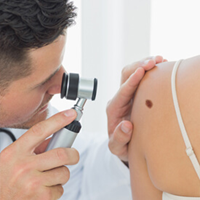About Melanoma
Melanoma Reviews
Known Causes
You have probably heard that over exposure to the sun and ultraviolet rays can cause skin cancer. Did you know there are genetic markers in your DNA that could possibly increase your risk of developing cancer? If you have a family member (a primary relative — a parent, sibling, or child) with a melanoma your chances are higher. We also know people of all ages with blonde or red hair, light colored eyes, and/or repeat sun exposure (with or without burns). Existing moles can also change into a melanoma. The lesion on your skin does not need to be a new, either to transform into skin cancer.
Presenting Symptoms
Skin cancer at an aggressive stage can present in just one or a variety of ways when it comes to melanoma. We understand that not everyone recognizes the ABCDEs of skin cancer, which is why having regular skin cancer screenings by a trained eye can be beneficial. Let us educate you on the presenting symptoms of melanoma with the ABCDE rules of skin cancer signs:
- A: Asymmetry (it will not look the same on all sides if you were looking at each side of the lesion)
- B: Border appearance (you will not see a defined border on a malignancy)
- C: Color (you may see one color or multiple colors within the lesion that can change)
- D: Diameter (melanomas get bigger as they progress in your skin)
- E: Evolving (the lesion on your skin that could be a melanoma will constantly morph)
Please make an appointment with your SkinMD provider or trusted family doctor to have a skin cancer screening if you are worried about a certain spot on your body.
What to Expect
If you do have melanoma, we will discuss the appropriate treatment options for you as soon as the diagnostic testing confirms your condition. Treatment decisions will be made on the characteristics of the malignancy, how far it has progressed, the size, the depth, and the location of the growth. Our providers will work with any healthcare professional you need during your melanoma treatment. There are four stages of melanoma, and each stage has treatment options based on the condition of the skin. If abnormal skin cells are found on your skin and can be easily removed, a basic skin cell excision is all that is necessary.
Stage I Melanoma
You will need to have the tumor or growth surgically removed (possibly with lymph node mapping and lymph node removal as well).
Stage II Melanoma
Stage II melanoma also requires you to have surgery to excise the growth. The lymph nodes in the area will need to be biopsied in the event of a melanoma removal. You can expect that the lymph nodes will need to be taken out as well if there are cancer cells within it.
Stage III and IV Melanoma
The surgical procedure for Stage III melanoma can be very aggressive but necessary to get you healthy again. When an advanced-stage melanoma is taken from the skin, there will be quite a bit of tissue taken from the area that may need a skin graft. If the melanoma will not be effectively treated with surgery, then you may need to have other interventions such as chemotherapy, radiation, and other targeted treatments.
Not Your Typical Mole
If you have a question about a mole or a lesion on your skin that has recently appeared or is changing in appearance, you should have a skin evaluation at SkinMD in Hurst or Weatherford, TX. If you have a melanoma, which is malignant skin cancer, you will want to seek treatment as soon as possible. Come in for a skin cancer screening by making an appointment over the phone or fill out a request form here on our website.




